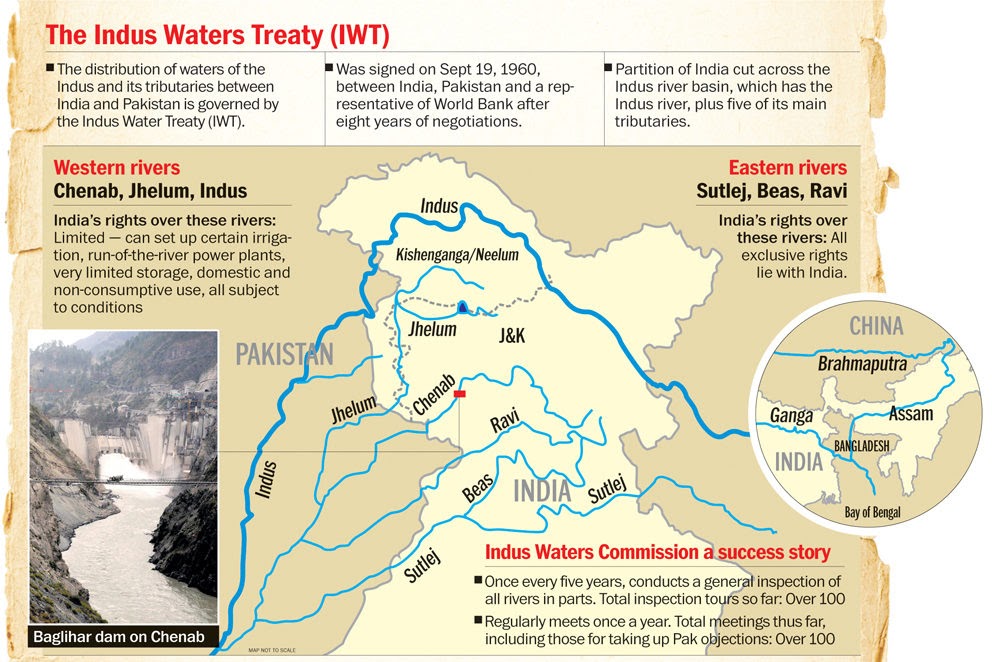International Relations
60 Years of Indus Water Treaty
- 19 Sep 2020
- 7 min read
Why in News
The Indus Water Treaty (IWT) between India and Pakistan marks its 60th anniversary on 19th September 2020.
Key Points
- About:

- The Indus system comprises the main Indus, Jhelum, Chenab, Ravi, Beas and Sutlej. The basin is mainly shared by India and Pakistan with a small share for China and Afghanistan.
- With the partition of India in 1947, waters of Indus rivers system were also divided.
- The sharing formula, devised after prolonged negotiations, sliced the Indus system into two halves. The three ‘western rivers’ (Indus, Jhelum and Chenab) went to Pakistan and the three ‘eastern rivers’ (Sutlej, Ravi and Beas) were portioned to India.
- India is allowed to use 20% water of the western rivers for irrigation, power generation and transport purposes.
- IWT granted 3.6 million acre-feet (MAF) of “permissible storage capacity” to India on the western rivers but due to poor water development projects, 2-3 MAF of water easily flows into Pakistan.
- It seemed equitable but India conceded 80.52% of the aggregate water flows in the Indus system to Pakistan and also gave Rs. 83 crore in pounds sterling to Pakistan to help build replacement canals from the western rivers.
- India conceded its upper riparian position on the western rivers for the complete rights on the eastern rivers.
- It was important to get the waters of the ‘eastern rivers’ for the Indira Gandhi Canal in Rajasthan (starts from the Harike Barrage, a few kilometers below the confluence of the Satluj and Beas rivers) and the Bhakra Dam (on the Sutlej River in Bilaspur, Himachal Pradesh) without which both Punjab and Rajasthan would be left dry, severely hampering India’s food production.
- The World Bank, as the third party, played a pivotal role in crafting the IWT.
- Pakistan’s Responses:
- The Pakistan leadership considers the sharing of the waters with India an unfinished business.
- Pakistan is not comfortable with the fact that India got away with the total flow of 33 million acre-feet on the eastern rivers, while it had to share the waters of western rivers.
- Being a lower riparian state, Pakistan’s scepticism of India allows it to increasingly politicise the issue. It maintains high troop levels and alertness around the canals on the eastern front, fearing that India will try to take control of the western rivers.
- Changing Perspectives in India:
- Every now and then, there is an uproar in India for abrogating the IWT as a response to Pakistan’s cross-border terrorism and tenacity.
- Abrogating IWT would require a number of politico-diplomatic and hydrological factors to be determined and also a political consensus.
- Terror attacks in Indian Parliament in 2001, Mumbai in 2008, and the incidents in Uri in 2016 and Pulwama in 2019 could have prompted India, within the Vienna Convention on the Law of Treaties, to withdraw from the IWT. However, on each occasion, India chose not to do so.
- Vienna Convention on the Law of Treaties, an international agreement governing treaties between states that was drafted by the International Law Commission of the United Nations.
- It was adopted in 1969 and entered into force in January 1980.
- It is because India respects its signature and values trans-boundary rivers as an important connector in the region in terms of both diplomacy and economic prosperity.
- However, in light of India being hesitant to abrogate the treaty, there have been suggestions to modify it.
- Currently, with a new set of hydrological realities, advanced engineering methods in dam construction and de-siltation, there is an urgent need to modify the treaty.
- Article XII of the IWT says that it “may from time to time be modified” but carefully notes “by a duly ratified treaty concluded for that purpose between the two governments”.
- Pakistan will see no merit in any modification, having already got a good deal in 1960.
- India’s best option, therefore, would be to optimise the provisions of the treaty.
- On the developments on western rivers, the permissible storage capacity on the western rivers needs to be urgently utilised. Out of the total estimated capacity of 11406 MW electricity that can be harnessed from the three western rivers in Kashmir, only 3034 MW has been tapped so far, which also needs to be looked into.
- Tulbul Navigation project on Jhelum, Ratle and Bagliha hydro projects on Chenab, Bursar hydroelectric project on one of the tributaries of the Chenab in Jammu and Kashmir are few of the projects to utilise the waters of western rivers.
- Bursar, once completed, will be India’s first project on the western rivers to have storage infrastructure.
- India has fast-tracked the work on Shahpur Kandi dam project, a second Sutlej-Beas link in Punjab and the Ujh Dam project in Jammu and Kashmir to fully utilise the waters of eastern rivers.
- Tulbul Navigation project on Jhelum, Ratle and Bagliha hydro projects on Chenab, Bursar hydroelectric project on one of the tributaries of the Chenab in Jammu and Kashmir are few of the projects to utilise the waters of western rivers.
- Every now and then, there is an uproar in India for abrogating the IWT as a response to Pakistan’s cross-border terrorism and tenacity.
Way Forward
- The role of India, as a responsible upper riparian abiding by the provisions of the treaty, has been remarkable but the country is under pressure to rethink the extent to which it can remain committed to the provisions, as its overall political relations with Pakistan becomes intractable.
- IWT is often cited as an example of the possibilities of peaceful coexistence that exist despite the troubled relationship between both neighbouring countries.






